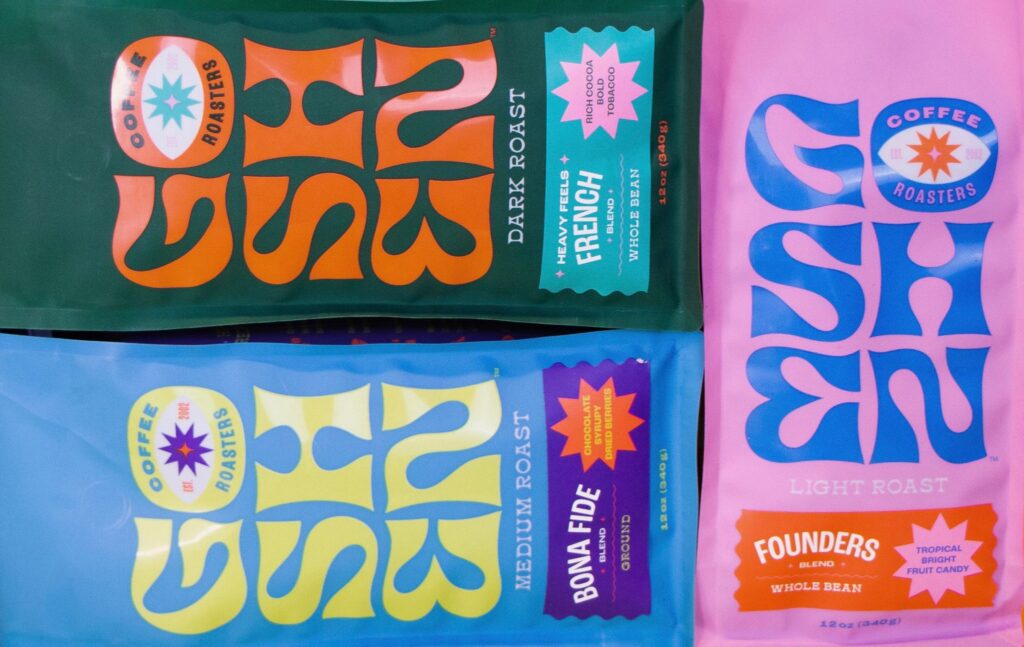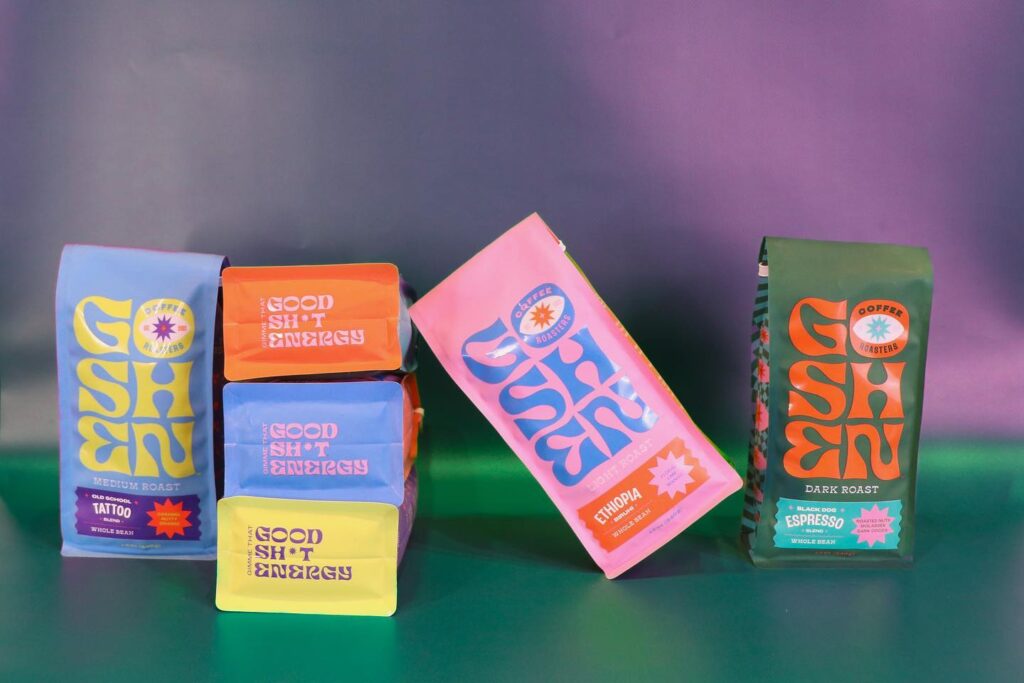For Goshen Coffee, the right moment to rebrand came after twenty years of business. Based in Edwardsville, Illinois, just outside St. Louis, they’d been serving specialty coffee to the St. Louis metro area since 2002. But with plans to expand nationwide and open new locations, they knew they needed a brand refresh.
Their old packaging had served them well but no longer fit their goals. The dark color palette and Rosie the Riveter-inspired character felt out of sync with their bigger vision. “We knew if we wanted to attract the consumer on the shelf, we needed an image that would pop and draw the consumer to pick up the package,” says Jennifer Hughey, owner and CEO of Goshen.
But this rebrand wasn’t just about a new look: it was also about redefining Goshen’s identity. Hughey knew their packaging had to be more than just eye-catching to attract new customers—it needed to be approachable and inviting. Even with their success, Hughey saw a chance to tell a more compelling story that showed what makes Goshen stand out.
Rebranding can be a powerful tool for coffee companies looking to redefine their market presence, but timing is everything. While many see rebranding as a fix for existing issues, it can also be a strategic move to set up for future growth. So, how do owners know when it’s the right moment to refresh their brand?
Designing a New Era
While the region of Edwardsville, where the roastery is based, has historical ties to the biblical land of Goshen, the rebrand introduced a new angle with the slogan, “Good Sh*t Energy,” a play on the letters in Goshen.

Hughey and her team partnered with TOKY, a St. Louis creative studio, for the rebrand. The result, which debuted in 2023, was a bold new design featuring bright orange, pink, blue, and citrus colors mixed with psychedelic patterns and playful hand lettering.
The design process was hands-on, with TOKY presenting multiple design ideas before Hughey and her team selected their favorite. Plus, the rebrand set the stage for Goshen’s evolution, which allowed them to expand their coffee line and introduce new menu options. “They not only helped us with the core line but have been with us along this entire process as we’ve done line extensions with our single serve and Secret Stash lines of coffee,” says Hughey. The Secret Stash line features rare single-origin coffees, produced in small batches and released only once a year.
The bag colors represent different roast levels: pink for light roast, blue for medium roast, green for dark roast, and silver for seasonal blends. “Now we have amazing packaging, and the coffee inside is even better. If we can just get people to pick it up and try it, they’ll be hooked on Goshen too,” says Hughey.

As the team geared up to open their second location in St. Louis, the new design elements spilled over into the cafe. The space features decor with the same eye-catching patterns: checker-patterned wallpaper, ornate mirrors, and a neon sign that reads “Feel The Energy.”
Hughey finds that customers connect well to the refreshed brand and is eager to build on this momentum. “99% of the feedback has been positive, and we’re on a significant growth trajectory,” she says.
A New Chapter
Founded in 2015, Council Oak Supply began as a coffee shop in Sioux City, Iowa. As they grew and ventured into roasting four years in, they realized they were essentially managing two different businesses—one retail and one wholesale—with the same name. “It was confusing for our customers,” says Brad Lepper, the founding president. “We had customers coming to our roasting facility expecting the same experience as the cafe.”

They decided to sell the cafe to a local family and rebrand the roastery as Council Oak Supply. Lepper explains this change helped them clearly define their business focus and refine their brand story. “It was the right time based on the shift in the direction of the company. We took the opportunity with the new brand to implement the things we learned over the years and create a story that was easier for customers to connect with,” he says.
The name Council Oak Supply was inspired by a historic bur oak tree in Sioux City, known as the Council Oak. “The Council Oak was a landmark in our area, and the myth of this tree being a meeting place for people from different walks of life resonated with what we wanted our company to be,” says Lepper.



Council Oak Supply did its rebrand in-house. They drew inspiration from a former historic local chain of grocery stores called the Council Store. “They had some beautiful branding, so we leaned heavily on their brand identity, modernizing and cleaning it up a bit,” says Lepper.
Lepper says the key to successful branding is having a story people can connect with. The story of the Council Oak—a place where people would come together to negotiate—fit perfectly with their company’s vision. “The hero of our story isn’t us or the brand, but the customers and community members who come together and learn from each other.”
The Long-Term Payoff
Even if a coffee company decides now is the right time to rebrand, there’s always a question of whether the investment will pay off. Measuring the impact can be tricky because it’s hard to isolate the effects of a new brand from other factors influencing growth.
For Hughey, it’s tough to pinpoint the impact of Goshen’s rebrand since they were already on a growth trajectory. “The retail business more than doubled in that first year [after the rebrand]—and we continue to see serious growth from that standpoint,” says Hughey. She says the brand has grown by 300% over the last three years.

The benefits of rebranding can take time to show. Long-term successes like awards and industry recognition are good signs that a rebrand is making an impact. TOKY earned an ADDY award in the Packaging and Integrated Brand categories for their work on the new packaging. “Whenever you relaunch, it takes a while for people to buy into that, but we’ve been winning awards year after year,” says Hughey.
Ultimately, rebranding is about finding the right moment to update an existing brand while keeping its core identity intact. But refreshing a brand doesn’t always mean starting from scratch. Sometimes, small updates like tweaking colors or refining design elements can make a big difference. Hughey adds, “If you refresh your brand slightly, like adjusting the color palette or making minor updates, it can attract new attention without losing the essence of what makes your brand unique.”
Since branding is deeply personal and often tied to a company’s history, Hughey says changing a brand can sometimes feel like a bold move that may alienate loyal customers. But with careful planning and a clear vision, Hugley also believes a rebrand can offer exciting new opportunities and attract a wider audience. “If you have a solid brand, refreshing it every few years can be incredibly beneficial.”
















